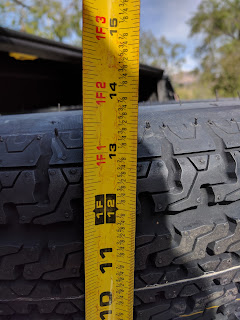We should have done the bearings and tires when we had the body off the frame. At the time, we always had it in the back of our mind that the thing might end up at the dump, so why waste the money on new tires.
Now, towards the end of the project, with our registration date approaching at the end of the month, we finally needed to stop procrastinating. First task, get the wheels off. For this, we put the frame on 4 jack stands and took the wheels to Costco.
We had ordered the tires online earlier in the week. They are Greenball radial tires vs the old bias ply tires originally installed on the trailer. Compared to the 32" tires on the truck, these little 24" tires on 13" rims are tiny.
We were a little worried about the new tires fitting. Many online sources said radials could be wider than bias ply. Turns out, even after mounting, the new tires are actually narrower. The radials should also get better mileage and run cooler.
With the tires back at home in under 2 hours (including a few other errands), it was time to address the hubs and bearings. There are many tutorials online about greasing trailer bearings, so this won't be another one. Suffice it to say, the potentially scary process was pretty easy.
Getting both hubs disassembled and cleaned was a pretty quick process. We finally found a use for our dopey corporate magazine.

Getting the rear bearings out requires a special tool. I didn't have the right diameter pipe to push them out and didn't want to use anything damaging, so I "borrowed" some 1-1/4" pipe from a neighbor and sanded it down to the right outside diameter to push the bearing and seal out.
All nice and clean and ready for new grease.
The reassembled hub
The cotter pins originally used were very small 1" size, so the wife ran out and got some longer pins to make sure the castle nut was secure.
The wheels back on and ready to roll.
We sorta changed our mind on the color to paint the rims, so will hold off until we paint the whole thing.
With the rest of our weekend, we started reinstalling the trim that covers up each panel seam. It's quite a bit darker than the new birch, even with only clear shellac, but it's a look that's growing on us. We have to add some more shellac to a few panels anyways, so they will darken up a bit more.






















































